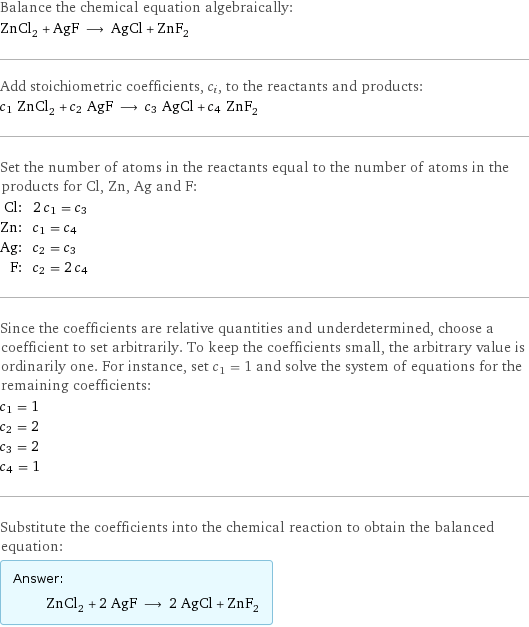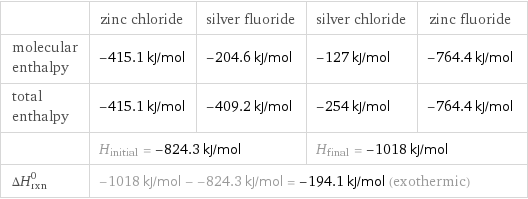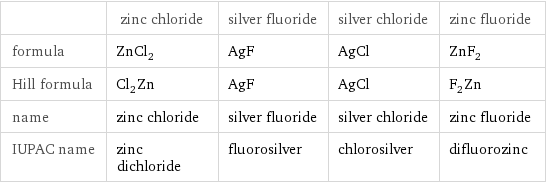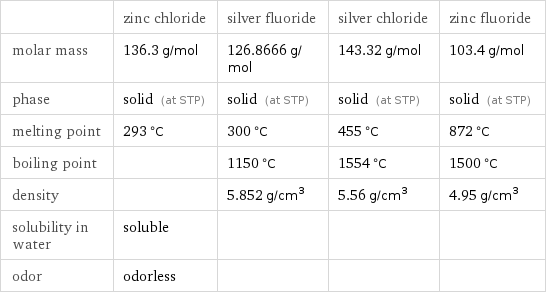Input interpretation

ZnCl_2 zinc chloride + AgF silver fluoride ⟶ AgCl silver chloride + ZnF_2 zinc fluoride
Balanced equation

Balance the chemical equation algebraically: ZnCl_2 + AgF ⟶ AgCl + ZnF_2 Add stoichiometric coefficients, c_i, to the reactants and products: c_1 ZnCl_2 + c_2 AgF ⟶ c_3 AgCl + c_4 ZnF_2 Set the number of atoms in the reactants equal to the number of atoms in the products for Cl, Zn, Ag and F: Cl: | 2 c_1 = c_3 Zn: | c_1 = c_4 Ag: | c_2 = c_3 F: | c_2 = 2 c_4 Since the coefficients are relative quantities and underdetermined, choose a coefficient to set arbitrarily. To keep the coefficients small, the arbitrary value is ordinarily one. For instance, set c_1 = 1 and solve the system of equations for the remaining coefficients: c_1 = 1 c_2 = 2 c_3 = 2 c_4 = 1 Substitute the coefficients into the chemical reaction to obtain the balanced equation: Answer: | | ZnCl_2 + 2 AgF ⟶ 2 AgCl + ZnF_2
Structures

+ ⟶ +
Names

zinc chloride + silver fluoride ⟶ silver chloride + zinc fluoride
Reaction thermodynamics
Enthalpy

| zinc chloride | silver fluoride | silver chloride | zinc fluoride molecular enthalpy | -415.1 kJ/mol | -204.6 kJ/mol | -127 kJ/mol | -764.4 kJ/mol total enthalpy | -415.1 kJ/mol | -409.2 kJ/mol | -254 kJ/mol | -764.4 kJ/mol | H_initial = -824.3 kJ/mol | | H_final = -1018 kJ/mol | ΔH_rxn^0 | -1018 kJ/mol - -824.3 kJ/mol = -194.1 kJ/mol (exothermic) | | |
Equilibrium constant
![Construct the equilibrium constant, K, expression for: ZnCl_2 + AgF ⟶ AgCl + ZnF_2 Plan: • Balance the chemical equation. • Determine the stoichiometric numbers. • Assemble the activity expression for each chemical species. • Use the activity expressions to build the equilibrium constant expression. Write the balanced chemical equation: ZnCl_2 + 2 AgF ⟶ 2 AgCl + ZnF_2 Assign stoichiometric numbers, ν_i, using the stoichiometric coefficients, c_i, from the balanced chemical equation in the following manner: ν_i = -c_i for reactants and ν_i = c_i for products: chemical species | c_i | ν_i ZnCl_2 | 1 | -1 AgF | 2 | -2 AgCl | 2 | 2 ZnF_2 | 1 | 1 Assemble the activity expressions accounting for the state of matter and ν_i: chemical species | c_i | ν_i | activity expression ZnCl_2 | 1 | -1 | ([ZnCl2])^(-1) AgF | 2 | -2 | ([AgF])^(-2) AgCl | 2 | 2 | ([AgCl])^2 ZnF_2 | 1 | 1 | [ZnF2] The equilibrium constant symbol in the concentration basis is: K_c Mulitply the activity expressions to arrive at the K_c expression: Answer: | | K_c = ([ZnCl2])^(-1) ([AgF])^(-2) ([AgCl])^2 [ZnF2] = (([AgCl])^2 [ZnF2])/([ZnCl2] ([AgF])^2)](../image_source/b29421c778b0e20420251c88995c0bfa.png)
Construct the equilibrium constant, K, expression for: ZnCl_2 + AgF ⟶ AgCl + ZnF_2 Plan: • Balance the chemical equation. • Determine the stoichiometric numbers. • Assemble the activity expression for each chemical species. • Use the activity expressions to build the equilibrium constant expression. Write the balanced chemical equation: ZnCl_2 + 2 AgF ⟶ 2 AgCl + ZnF_2 Assign stoichiometric numbers, ν_i, using the stoichiometric coefficients, c_i, from the balanced chemical equation in the following manner: ν_i = -c_i for reactants and ν_i = c_i for products: chemical species | c_i | ν_i ZnCl_2 | 1 | -1 AgF | 2 | -2 AgCl | 2 | 2 ZnF_2 | 1 | 1 Assemble the activity expressions accounting for the state of matter and ν_i: chemical species | c_i | ν_i | activity expression ZnCl_2 | 1 | -1 | ([ZnCl2])^(-1) AgF | 2 | -2 | ([AgF])^(-2) AgCl | 2 | 2 | ([AgCl])^2 ZnF_2 | 1 | 1 | [ZnF2] The equilibrium constant symbol in the concentration basis is: K_c Mulitply the activity expressions to arrive at the K_c expression: Answer: | | K_c = ([ZnCl2])^(-1) ([AgF])^(-2) ([AgCl])^2 [ZnF2] = (([AgCl])^2 [ZnF2])/([ZnCl2] ([AgF])^2)
Rate of reaction
![Construct the rate of reaction expression for: ZnCl_2 + AgF ⟶ AgCl + ZnF_2 Plan: • Balance the chemical equation. • Determine the stoichiometric numbers. • Assemble the rate term for each chemical species. • Write the rate of reaction expression. Write the balanced chemical equation: ZnCl_2 + 2 AgF ⟶ 2 AgCl + ZnF_2 Assign stoichiometric numbers, ν_i, using the stoichiometric coefficients, c_i, from the balanced chemical equation in the following manner: ν_i = -c_i for reactants and ν_i = c_i for products: chemical species | c_i | ν_i ZnCl_2 | 1 | -1 AgF | 2 | -2 AgCl | 2 | 2 ZnF_2 | 1 | 1 The rate term for each chemical species, B_i, is 1/ν_i(Δ[B_i])/(Δt) where [B_i] is the amount concentration and t is time: chemical species | c_i | ν_i | rate term ZnCl_2 | 1 | -1 | -(Δ[ZnCl2])/(Δt) AgF | 2 | -2 | -1/2 (Δ[AgF])/(Δt) AgCl | 2 | 2 | 1/2 (Δ[AgCl])/(Δt) ZnF_2 | 1 | 1 | (Δ[ZnF2])/(Δt) (for infinitesimal rate of change, replace Δ with d) Set the rate terms equal to each other to arrive at the rate expression: Answer: | | rate = -(Δ[ZnCl2])/(Δt) = -1/2 (Δ[AgF])/(Δt) = 1/2 (Δ[AgCl])/(Δt) = (Δ[ZnF2])/(Δt) (assuming constant volume and no accumulation of intermediates or side products)](../image_source/01d7f5e8a3bcfed825711214be3b590f.png)
Construct the rate of reaction expression for: ZnCl_2 + AgF ⟶ AgCl + ZnF_2 Plan: • Balance the chemical equation. • Determine the stoichiometric numbers. • Assemble the rate term for each chemical species. • Write the rate of reaction expression. Write the balanced chemical equation: ZnCl_2 + 2 AgF ⟶ 2 AgCl + ZnF_2 Assign stoichiometric numbers, ν_i, using the stoichiometric coefficients, c_i, from the balanced chemical equation in the following manner: ν_i = -c_i for reactants and ν_i = c_i for products: chemical species | c_i | ν_i ZnCl_2 | 1 | -1 AgF | 2 | -2 AgCl | 2 | 2 ZnF_2 | 1 | 1 The rate term for each chemical species, B_i, is 1/ν_i(Δ[B_i])/(Δt) where [B_i] is the amount concentration and t is time: chemical species | c_i | ν_i | rate term ZnCl_2 | 1 | -1 | -(Δ[ZnCl2])/(Δt) AgF | 2 | -2 | -1/2 (Δ[AgF])/(Δt) AgCl | 2 | 2 | 1/2 (Δ[AgCl])/(Δt) ZnF_2 | 1 | 1 | (Δ[ZnF2])/(Δt) (for infinitesimal rate of change, replace Δ with d) Set the rate terms equal to each other to arrive at the rate expression: Answer: | | rate = -(Δ[ZnCl2])/(Δt) = -1/2 (Δ[AgF])/(Δt) = 1/2 (Δ[AgCl])/(Δt) = (Δ[ZnF2])/(Δt) (assuming constant volume and no accumulation of intermediates or side products)
Chemical names and formulas

| zinc chloride | silver fluoride | silver chloride | zinc fluoride formula | ZnCl_2 | AgF | AgCl | ZnF_2 Hill formula | Cl_2Zn | AgF | AgCl | F_2Zn name | zinc chloride | silver fluoride | silver chloride | zinc fluoride IUPAC name | zinc dichloride | fluorosilver | chlorosilver | difluorozinc
Substance properties

| zinc chloride | silver fluoride | silver chloride | zinc fluoride molar mass | 136.3 g/mol | 126.8666 g/mol | 143.32 g/mol | 103.4 g/mol phase | solid (at STP) | solid (at STP) | solid (at STP) | solid (at STP) melting point | 293 °C | 300 °C | 455 °C | 872 °C boiling point | | 1150 °C | 1554 °C | 1500 °C density | | 5.852 g/cm^3 | 5.56 g/cm^3 | 4.95 g/cm^3 solubility in water | soluble | | | odor | odorless | | |
Units
